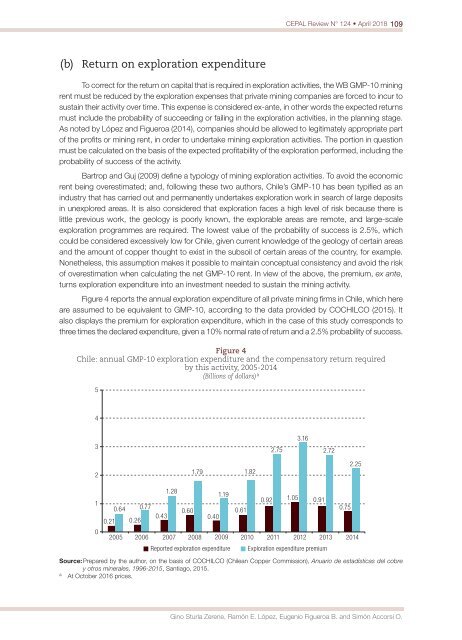CEPAL Review no. 124
April 2018
April 2018
Create successful ePaper yourself
Turn your PDF publications into a flip-book with our unique Google optimized e-Paper software.
<strong>CEPAL</strong> <strong>Review</strong> N° <strong>124</strong> • April 2018 109<br />
(b) Return on exploration expenditure<br />
To correct for the return on capital that is required in exploration activities, the WB GMP-10 mining<br />
rent must be reduced by the exploration expenses that private mining companies are forced to incur to<br />
sustain their activity over time. This expense is considered ex-ante, in other words the expected returns<br />
must include the probability of succeeding or failing in the exploration activities, in the planning stage.<br />
As <strong>no</strong>ted by López and Figueroa (2014), companies should be allowed to legitimately appropriate part<br />
of the profits or mining rent, in order to undertake mining exploration activities. The portion in question<br />
must be calculated on the basis of the expected profitability of the exploration performed, including the<br />
probability of success of the activity.<br />
Bartrop and Guj (2009) define a typology of mining exploration activities. To avoid the eco<strong>no</strong>mic<br />
rent being overestimated; and, following these two authors, Chile’s GMP-10 has been typified as an<br />
industry that has carried out and permanently undertakes exploration work in search of large deposits<br />
in unexplored areas. It is also considered that exploration faces a high level of risk because there is<br />
little previous work, the geology is poorly k<strong>no</strong>wn, the explorable areas are remote, and large-scale<br />
exploration programmes are required. The lowest value of the probability of success is 2.5%, which<br />
could be considered excessively low for Chile, given current k<strong>no</strong>wledge of the geology of certain areas<br />
and the amount of copper thought to exist in the subsoil of certain areas of the country, for example.<br />
Nonetheless, this assumption makes it possible to maintain conceptual consistency and avoid the risk<br />
of overestimation when calculating the net GMP-10 rent. In view of the above, the premium, ex ante,<br />
turns exploration expenditure into an investment needed to sustain the mining activity.<br />
Figure 4 reports the annual exploration expenditure of all private mining firms in Chile, which here<br />
are assumed to be equivalent to GMP-10, according to the data provided by COCHILCO (2015). It<br />
also displays the premium for exploration expenditure, which in the case of this study corresponds to<br />
three times the declared expenditure, given a 10% <strong>no</strong>rmal rate of return and a 2.5% probability of success.<br />
Figure 4<br />
Chile: annual GMP-10 exploration expenditure and the compensatory return required<br />
by this activity, 2005-2014<br />
(Billions of dollars) a<br />
5<br />
4<br />
3<br />
2.75<br />
3.16<br />
2.72<br />
2<br />
1.79<br />
1.82<br />
2.25<br />
1.28<br />
1.19<br />
0.92 1.05 0.91<br />
1<br />
0.64 0.77<br />
0.60<br />
0.61<br />
0.75<br />
0.43<br />
0.40<br />
0.21 0.26<br />
0<br />
2005 2006 2007 2008 2009 2010 2011 2012 2013 2014<br />
Reported exploration expenditure Exploration expenditure premium<br />
Source: Prepared by the author, on the basis of COCHILCO (Chilean Copper Commission), Anuario de estadísticas del cobre<br />
y otros minerales, 1996-2015, Santiago, 2015.<br />
a<br />
At October 2016 prices.<br />
Gi<strong>no</strong> Sturla Zerene, Ramón E. López, Eugenio Figueroa B. and Simón Accorsi O.


















